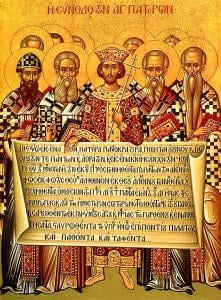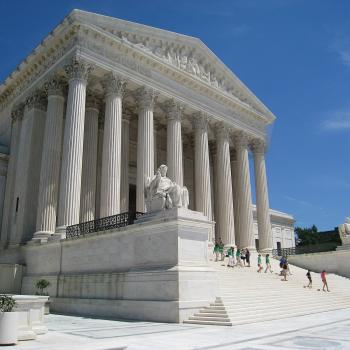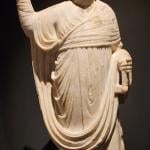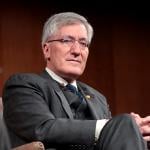In May or June 325, several hundred bishops from across the Christian world met in Nicaea, as Constantine frames it, to “face the cause of the division among you” (Constantine, Speech to the Nicene Synod, FNS 31). The divisions were theological ones, sparked from a debate between the presbyter Arius and his bishop Alexander of Alexandria, but had overflowed into the broader world. This council and the resulting creed have received exceptional attention in theological and doxological reflection, especially as it is recited by millions of Christians every week on Sunday. These reflections have sometimes obscured something important though—as a historical event, the council is shrouded in mystery. There is little documentation from the council of Nicaea itself, apart from the creed and canons.
This year marks the 1700-year anniversary of Nicaea, which has prompted patristic scholars and theologians around the world (including myself) to dwell on the council historically, theologically, and pastorally. In tandem with this research, I have decided to focus on several related issues about the council here on the Anxious Bench in my next few posts.
One central issue for understanding the council is the role of emperor Constantine. An ecumenical council was tangled up in imperial politics—how does this make us reconsider Nicene theology? Is the orthodoxy we associate with Nicaea the product of political power or theological accuracy?
(Un)Tangling Political and Theological Aims in the Debates before Nicaea
What led to the theological disagreement between Arius and Alexander that sparked this entire debate? It seems to be primarily concerned with the nature of the Godhead, especially on how the Son relates to the Father. As best we can tell, sometime between 318 and 322 Arius preaches a theology which emphasizes the supremacy of the Father and the Son’s dependence on him for existence (hence the famous line, ‘there was a time when the Son was not’). Alexander, conversely, emphasizes the eternality of the Son, which put him in sharp contrast with Arius. But, investigating both of their theological systems is an exceedingly difficult task, as the evidence is so fragmentary (For an impressive attempt, see: Rowan Williams, Arius: Heresy and Tradition). In any case, this debate spreads throughout the whole empire, but not in the way we might assume. It is not as if Arius published a coherent set of trinitarian doctrine and acquired an extensive group of followers across the empire. Rather, competing and corresponding visions of monotheism, the eternal generation of the Son, even worship, prompted theological alliances to form between figures who often had unique theological systems. To defend Arius was not to be an Arian nor was supporting Alexander to be ‘Nicene’, even if Athanasius frames it this way (see a post about this, here). But there was a common desire to establish the proper theological view and expel heresy, as seen in several local ecclesiastical councils over the issue before Nicaea.
So how does political power enter theological debate? Well, it takes place over a decade before the council of Nicaea. Constantine became Caesar Augustus of the Western portion of the empire in 306 and a Christian (though a bit of a loaded term when it comes to Constantine) in 312. While it was not until 324 that he would become emperor over the entire Roman Empire, he had already entered the Donatist Controversy in Northern Africa a decade earlier, in a desire to “cut short such dissensions among them” (Eusebius, Ecclesiastical History 10.5.21) by calling a council. In 314, bishops from across Constantine’s portion of the empire met at the Council of Arles to discuss the so-called ‘Donatists’, ultimately condemning them. There, he learned of the power of an empire wide council, especially for asserting his influence in the proceedings and outcome. So, too, after he became monarch in 324, he entered theological disputes by sending a trusted bishop, Ossius of Cordoba, to investigate the controversy in Alexandria and a condemnatory letter to both Arius and Alexander (Constantine, Letter to Alexander and Arius 24). Thereafter, he agreed with Ossius’ assessment that a large council was necessary which he set to take place in Nicaea (See: “Who Convened the First Council of Nicaea”, JTS 71;1 (2020); FNS 30). Constantine was not willing to a passive observer to theological controversy but used his authority in conjunction with ecclesiastical authorities to guide debate.
In all of this, we see a common desire from the bishops and Constantine for unity in the church. They likely had different conceptions about church peace though, the former being more concerned with doctrinal uniformity through the excision of heresy, the latter through the healing of the church through broad consensus of belief, perhaps for political reasons (See: Eusebius, Life of Constantine 2.65.1). While these desires overlapped, they are not the same.
Developing a(n Imperial) Theology at Nicaea
At the council itself, the bishops engaged one another in theological debate. They read documents from those present to prove orthodoxy or condemn heresy (Eustathius, On Prov 8:22, FNS 39), made suggestions for phrases in the creed (Athanasius, To the Bishops of Africa, 5), and clarified ambiguous terms (Eusebius, Letter to his Church, FNS 37). Nicene theology was developed by the majority with an eye to Christianity from the east and the west, using Scriptural language (for discussion, see a previous post of mine). But, as we sometimes forget, Constantine was present.
This presence was not a silent nor an inconspicuous one. Not only was he the patron of the whole event, providing transportation (Eusebius, Life of Constantine 3.6), meals (3.9), and the location for the sessions in the palace (3.10), but he also processed into the council “like some heavenly angel of God…shining with the fiery radiance of a purple robe, and decorated with the dazzling brilliance of gold and precious stones” (3.10). The power of this act would have not been lost on the bishops who all stood when he walked in—Constantine entered in the performative style of a late Roman court to “insure that his own priorities of unity and harmony were not ignored” (Drake, “Constantine at the Council,” 125). Throughout the sessions, he spoke frequently and guided the debate with his approving and mild comments, perhaps even supplying the famous term ‘homoousios’ (if Eusebius is to be believed). This should not lead us to the assumption that Constantine necessarily favored only one position in this debate—according to Athanasius, he was committed to both sides (Theodoret, Church History 1.7). It must be noted that Constantine’s chief end of unity seems to be accomplished in the creed—only a few were condemned, and most were able to sign the creed without coercion. Constantine’s political priorities were widespread Christian unity and the inclusion of as many as possible in a broad theological tent, and they are reflected in the outcomes of the council.

Orthodoxy—Theology or Power?
How do we tell the story of Nicaea? For some, the council is one of theological victory over the recent aberration that is Arianism—Nicene theology is orthodox theology because its understanding of God is in continuity with earlier theology and accurately defines God’s nature and activity. For others, Nicene theology is a political victory because it is married to imperial powers—this event is not foremost about understanding God rightly, but about enforcing a particular vision of Christianity that suited the powerful, thus marginalizing other legitimate forms of the Christian faith. Orthodoxy is either about proper theology or powerful politics.
I have issues with the way we tell these stories in two ways. First, there is often an assumption that they must conflict with one another. To hold to a theological narrative for the council is to deny the political narrative and vice versa. But the documentation clearly affirms both and the bishops present have no qualms with Constantine’s participation. In the ancient world, it was normal for an emperor to speak into religious matters—it is simply that none had done so for the Christian faith yet. As H.A. Drake comments, Constantine’s participation “was neither an unwarranted intrusion nor a hostile takeover by a secular ruler; it was innovative, but only in the sense that… he was the first to extend his traditional role to the unique requirements of the new faith” (Drake, “Constantine at the Council,” 130). Second, it is not clear that either of these stories of victory—a theological one or political one—is actually a victory. The theological story forgets what Sara Parvis makes clear: the so-called Arians win. Supporters of Alexander regarded Nicaea “not as a triumph but a failure” (Parvis, Marcellus of Ancyra 5), as the creed condemned only Arius (and two others after the council) and Arius was reinstated two or three years later by Constantine himself. Nicene theology was not the victor for quite some time and in some places in Europe it was not secured until the Third council of Toledo in 589, 250 years later. The political story forgets that Constantine’s vision of Christianity did not win, even as he enforced his religious policies. Constantine seems most concerned with ecclesiastical unity over doctrinal uniformity at Nicaea, but that fails—the subsequent decades display disunity and debates amongst Christians throughout the Roman Empire over these exact issues.
As modern western Christians, we are suspicious of any political power speaking into theological issues. And this is a good impulse! We should be skeptical of any statement that demands doctrinal uniformity published from the White House, particularly given the very different political frameworks of modern nation states and the ancient world. If a modern political figure seeks to impose a narrow theological vision on a majority, to promote a particular nation or national priorities instead of the global church, or to exclude Christian voices that disagree, they’re not following approaches that reflect the reality of Constantine’s engagement in the church. Constantine tries to cast a wide net, rather than a narrow one. Further, just because Constantine entered into theological debates does not mean this is a model for church state relations moving forward. But to investigate the proceedings at Nicaea as historical events is to acknowledge the collision of theological and political powers, both of whom had corresponding (but not identical) aims. They need not be held in opposition, but they do need to be held in tension as we investigate this important event and its creed. In other words, my question at the outset is a bit unfair by driving a wedge between politics and theology at Nicaea: Nicene orthodoxy is the product of political power and theological accuracy, at least if we take all the historical evidence into consideration.













